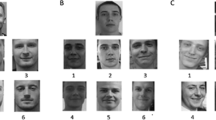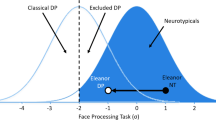Abstract
Background
There is evidence that deficit schizophrenia (DS) is associated with neuroanatomical changes in structures including those involved in olfaction. Olfactory dysfunction, which includes impaired odor identification, is found in patients with schizophrenia and their family members.
Methods
82 patients with DS and 72 patients with NDS (nondeficit schizophrenia), somatically healthy and without acute psychotic symptoms undertook a smell identification test using the 16-item Sniffin’ Sticks ID test. Demographic and psychometric data were collected.
Results
No differences in the course of the illness, perinatal history and demographic data were found between the DS and NDS groups. No differences in the number of correctly identified odor samples were found. Some differences in the qualitative identification of samples between DS and NDS were found in the groups of female (fewer correct identifications of cinnamon and pineapple smells in DS) and male patients (fewer correct identifications of the smell of rose and more correct identifications of the smell of orange than in NDS).
Conclusions
No overall differences between DS and NDS regarding odors identification have been found. The results seem to indicate some specific deficits in the identification of markers of rose, pineapple, orange and cinnamon.
Similar content being viewed by others
Abbreviations
- ALT:
-
alanine transaminase
- AST:
-
aspartate transaminase
- CNS:
-
central nervous system
- DS:
-
deficit schizophrenia
- DSM IV:
-
Diagnostic and Statistical Manual of Mental Disorders, Forth Edition
- DUP:
-
duration of untreated psychosis
- GABA:
-
γ-aminobutyric acid
- ICD10:
-
International Statistical Classification of Diseases and Related Health Problems, Tenth Edition
- MINI:
-
Mini International Neuropsychiatric Interview
- NDS:
-
non deficit schizophrenia
- OPCRIT:
-
Operational Criteria for Psychotic Illness
- PANSS:
-
Positive and Negative Syndrome Scale
- SDS:
-
Schedule for the Deficit Syndrome
- S’S:
-
Sniffin Sticks
- TSH:
-
thyroid-stimulating hormone
References
Carpenter W, Heinrichs D, Wagman AI. Deficit and nondeficit forms of schizophrenia: the concept. Am J Psychiatry 1988;145(5):578–83.
Kirkpatrick B, Buchanan R, Ross D, Carpenter Jr. W. A separate disease within the syndrome of schizophrenia. Arch Gen Psychiatry 2001;58(2):165–71.
Galderisi S, Maj M. Deficit schizophrenia: an overview of clinical, biological and treatment aspects. Eur Psychiatry 2009;24(8):493–500.
Kirkpatrick B, Fenton W, Carpenter Jr. W, Marder S. The NIMH-MATRICS consensus statement on negative symptoms. Schizophr Bull 2006;32(2):214–9.
Milev P, Ho B, Arndt S, Andreasen N. Predictive values of neurocognition and negative symptoms on functional outcome in schizophrenia: a longitudinal first-episode study with 7-year follow-up. Am J Psychiatry 2005;162(3):495–506
Fenton W, McGlashan T. Antecedents, symptom progression, and long-term outcome of the deficit syndrome in schizophrenia. Am J Psychiatry 1994;151(3):351–6.
Fenton W, McGlashan T. Testing systems for assessment of negative symptoms in schizophrenia. Arch Gen Psychiatry 1992;49(3):179–84.
Bienkowski P, Samochowiec J, Pelka-Wysiecka J, Grzywacz A, Skibinska M, Jasiewicz A, et al. Functional polymorphism of matrix metalloproteinase-9 (MMP9) gene is not associated with schizophrenia and with its deficit subtype. Pharmacol Rep 2015;67(3):442–5.
Pełka-Wysiecka J, Wroński M, Jasiewicz A, Grzywacz A, Tybura P, Kucharska-Mazur J, et al. BDNF rs 6265 polymorphism and COMT rs 4680 polymorphism in deficit schizophrenia in Polish sample. Pharmacol Rep 2013;65(5):1185–93.
Galderisi S, Maj M, Mucci A, Cassano G, Invernizzi G, Rossi A, et al. Historical, psychopathological, neurological and neuropsychological aspects of deficit schizophrenia: a multicenter study. Am J Psychiatry 2002;159(6):983–90.
Kirkpatrick B, Conley R, Kakoyannis A, Reep R, Roberts R. Interstitial cells of the white matter in the inferior parietal cortex in schizophrenia: an unbiased cell-counting study. Synapse 1999;34(2):95–102.
Kirkpatrick B, Messias N, Conley R, Roberts R. Interstitial cells of the white matter in the dorsolateral prefrontal cortex in deficit and nondeficit schizophrenia. J Nerv Ment Dis 2003;19(9):563–7.
Moberg P, Agrin R, Gur R, Turetsky B, Doty R. Olfactory dysfunction in schizophrenia: a qualitative and quantitative review. Neuropsychopharmacology 1999;21(3):325–40.
Stockhorst U, Pietrowsky R. Olfactory perception, communication, and the nose-to-brain pathway. Physiol Behav 2004;83(1):3–11.
Kosaka T, Kosaka K. Interneurons in the olfactory bulb revisited. Neurosci Res 2011;69(2):93–9.
Barresi M, Ciurleo R, Giacoppo S, Foti Cuzzola V, Celi D, Bramanti P, et al. Evaluation of olfactory dysfunction in neurodegenerative diseases. J Neurol Sci 2012;323(1–2):16–24.
Kayser J, Tenke C, Kroppmann C, Alschuler D, Ben-David S, Fekri S, et al. Olfaction in the psychosis prodrome: electrophysiological and behavioral measures of odor detection. Int J Psychophysiol 2013;90(2):190–206.
Moberg P, Kamath V, Marchetto D, Calkins M, Doty R, Hahn C, et al. Metaanalysis of olfactory function in schizophrenia, first-degree family members, and youths at-risk for psychosis. Schizophr Bull 2014;40(1):50–9.
Kopala L, Clark C, Hurwitz T. Olfactory deficits in neuroleptic naive patients with schizophrenia. Schi Res 1992;8(3):245–50.
Moberg P, Doty R, Turetsky B, Arnold S, Mah R, Gur R, et al. Olfactory identification deficits in schizophrenia: correlation with duration of illness. Am J Psychiatry 1997;154(7):1016–8.
Kamath V, Turetsky B, Calkins M, Kohler C, Conroy C, Borgmann-Winter K, et al. Olfactory processing in schizophrenia, non-ill first-degree family members, and young people at-risk for psychosis. World J Biol Psychiatry 2011;10:1–10.
Brewer W, Pantelis C, Anderson V, Velakoulis D, Singh B, Copolov D, et al. Stability of olfactory identification deficits in neuroleptic-naive patients with first-episode psychosis. Am J Psychiatry 2001;158(1):107–15.
Martzke J, Kopala L, Good K. Olfactory dysfunction in neuropsychiatric disorders: review and methodological considerations. Biol Psychiatry 1997;42(8):721–32.
Geddes J, Huws R, Pratt P. Olfactory acuity in the positive and negative syndromes of schizophrenia. Biol Psychiatry 1991;29(8):774–8.
Brewer W, Edwards J, Anderson V, Robinson T, Pantelis C. Neuropsychological, olfactory, and hygiene deficits in men with negative symptom schizophrenia. Biol Psychiatry 1996;40(10):1021–31.
Seckinger R, Goudsmit N, Coleman E, Harkavy-Friedman J, Yale S, Rosenfield PJ, et al. Olfactory identification and WAIS-R performance in deficit and non-deficit schizophrenia. Schizophr Res 2004;69(1):55–65.
Malaspina D, Coleman E, Goetz R, Harkavy-Friedman J, Corcoran C, Amador X, et al. Odor identification, eye tracking and deficit syndrome schizophrenia. Biol Psychiatry 2002;51(10):809–15.
Strauss G, Allen D, Ross S, Duke L, Schwartz J. Olfactory hedonic judgment in patients with deficit syndrome schizophrenia. Schizophr Bull 2010; 36(4):860–8.
Jarema M, Kiejna A, Landowski J, Meder J, Rabe-Jablonska J, Rybakowski J. Pharmacological standards. In: Schizophrenia treatment. Psychiatr Pol 2006;40:1171–205.
Tybura P, Samochowiec A, Beszlej A, Grzywacz A, Mak M, Frydecka D, et al. Some dopaminergic genes polymorphisms are not associated with response to antipsychotic drugs in schizophrenic patients. Pharmacol Rep 2012;64(3): 528–35.
Jaracz J, Tetera-Rudnicka E, Kujath D, Raczyńska A, Stoszek S, Czernaś W, et al. The prevalence of antipsychotic polypharmacy in schizophrenic patients discharged from psychiatric units in Poland. Pharmacol Rep 2014;66(4):613–7.
Jarema M, Wichniak A, Dudek D, Samochowiec J, Bieńkowski P, Rybakowski J. Guidelines for the use of second-generation long-acting antipsychotics. Psychiatr Pol 2015;49(2):225–41.
Sawicka M, Charzyńska K. The role of a psychiatrist in treatment and recovery process of persons suffering from schizophrenia. Psychiatr Pol 2015;49(2):377–89.
McGuffin P, Farmer A, Harvey I. A polydiagnostic application of operational criteria in studies of psychotic illness. Development and reliability of the OPCRIT system. Arch Gen Psychiatry 1991;48(8):764–70.
Sheehan D, Lecrubier Y, Sheehan K, Amorim P, Janavs J, Weiller E, et al. The Mini-International Neuropsychiatric Interview (M.I.N.I.): the development and validation of a structured diagnostic psychiatric interview for DSM-IV and ICD-10. J Clin Psychiatry 1998;59(Suppl 20):22–33.
Leucht S, Kissling W, Davis J. The PANSS should be rescaled. Schizophr Bull 2010;36(3):461–2.
Kirkpatrick B, Buchanan R, McKenney P, Alphs L, Carpenter W. The Schedule for the Deficit Syndrome: an instrument for research in schizophrenia. Psychiatry Res 1989;30(2):119–24.
Hummel T, Kobal G, Gudziol H, Mackay-Sim A. Normative data for the Sniffin’ Sticks including tests of odor identification, odor discrimination, and olfactory thresholds: an upgrade based on a group of more than 3,000 subjects. Eur Arch Otorhinolaryngol 2007;264(3):237–43.
Hummel T, Sekinger B, Wolf S, Paul E, Kobal G. Sniffin’ Sticks: olfactory performance assessed by the combined testing of odor identification, odor discrimination and olfactory threshold. Chem Senses 1997;22(1):39–52.
Temmel A, Quint C, Schickinger-Fischer B, Klimek L, Stoller E, Hummel T. Characteristics of olfactory disorders in relation to major causes of olfactory loss. Arch Otolaryngol Head Neck Surg 2002;128(6):635–41.
McKinnon J, Demaerschalk BM, Caviness JN, Wellik KE, Adler CH, Wingerchuk DM. Sniffing out Parkinson disease: can olfactory testing differentiate Parkinsonian disorders? Neurologist 2007;13(6):382–5.
Urban M, Rabe-Jabłońska J. Olfactory dysfunctions in patients with schizophrenia. Psychiatr Pol 2007;41(4):503–12.
Scinska A, Wrobel E, Korkosz A, Zatorski P, Sienkiewicz-Jarosz H, Lojkowska W, et al. Depressive symptoms and olfactory function in older adults. Psychiatry Clin Neurosci 2008;62(4):450–6.
Swiecicki L, Zatorski P, Bzinkowska D, Sienkiewicz-Jarosz H, Szyndler J, Scinska A. Gustatory and olfactory function in patients with unipolar and bipolar depression. Prog Neuropsychopharmacol Biol Psychiatry 2009;33(5):827–34.
Kopala L, Good K, Honer W. Olfactory identification ability in pre- and postmenopausal women with schizophrenia. Biol Psychiatry 1995;38(1):57–63.
Coleman E, Goetz R, Leitman D, Yale S, Stanford A, Gorman J, et al. Odor identification impairments in schizophrenia: relationship with demographic measures, clinical variables, and diagnostic subtypes. CNS Spectr 2002;7(1):43–8.
Good KP, Whitehorn D, Rui Q, Milliken H, Kopala L. Olfactory identification deficits in first-episode psychosis may predict patients at risk for persistent negative and disorganized or cognitive symptoms. Am J Psychiatry 2006;163(5):932–3.
Kopala L, Good K, Honer W. Olfactory hallucinations and olfactory identification ability in patients with schizophrenia and other psychiatric disorders. Schizophr Res 1994;12(3):205–11.
Malaspina D, Perera G, Lignelli A, Marshall R, Esser P, Storer S, et al. SPECT imaging of odor identification in schizophrenia. Psychiatry Res 1998;82(1):53–61.
Wu J, Buchsbaum M, Moy K, Denlea N, Kesslak P, Tseng H, et al. Olfactory memory in unmedicated schizophrenics. Schizophrenia Res 1993;9(1):41–7.
Kopala L, Good K, Morrison K, Basset A, Alda M, Honer W. Impaired olfactory identification in relatives of patients with familial schizophrenia. Am J Psychiatry 2001;158(8):1286–90.
Cohen A, Brown L, Auster T. Olfaction, “olfiction”, and the schizophrenia-spectrum: an updated meta-analysis on identification and acuity. Schizophr Res 2012;135(1–3):152–7.
Author information
Authors and Affiliations
Corresponding author
Rights and permissions
About this article
Cite this article
Pełka-Wysiecka, J., Wroński, M., Bieńkowski, P. et al. Odors identification differences in deficit and nondeficit schizophrenia. Pharmacol. Rep 68, 390–395 (2016). https://doi.org/10.1016/j.pharep.2015.11.001
Received:
Revised:
Accepted:
Published:
Issue Date:
DOI: https://doi.org/10.1016/j.pharep.2015.11.001




